Photo
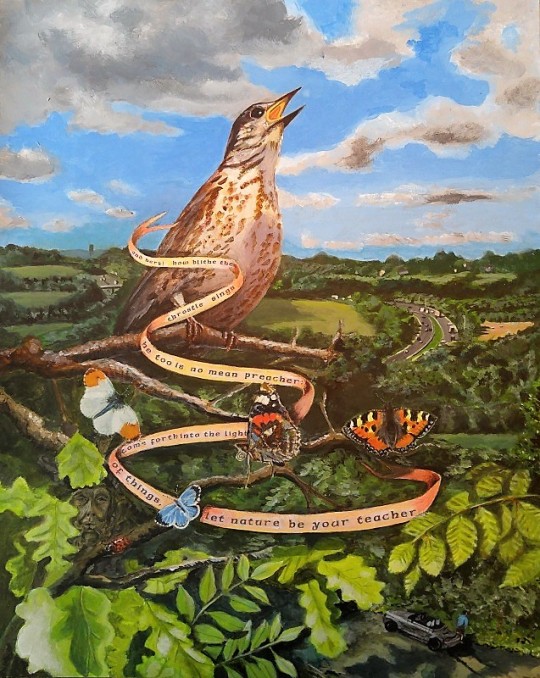
This is a larger painting that took some time to complete. While the subject is ostensibly a song thrush, it has multiple layers of symbolism. The essence of the work is the destruction of the natural environment for the benefit (and ultimately the doom) of one species – humans. The text is from Wordsworth, and it speaks for itself:
Up! up! my Friend, and quit your books; Or surely you’ll grow double: Up! up! my Friend, and clear your looks; Why all this toil and trouble?
The sun above the mountain’s head, A freshening lustre mellow Through all the long green fields has spread, His first sweet evening yellow.
Books! ’tis a dull and endless strife: Come, hear the woodland linnet, How sweet his music! on my life, There’s more of wisdom in it.
And hark! how blithe the throstle sings! He, too, is no mean preacher: Come forth into the light of things, Let Nature be your teacher.
She has a world of ready wealth, Our minds and hearts to bless— Spontaneous wisdom breathed by health, Truth breathed by cheerfulness.
One impulse from a vernal wood May teach you more of man, Of moral evil and of good, Than all the sages can.
Sweet is the lore which Nature brings; Our meddling intellect Mis-shapes the beauteous forms of things:— We murder to dissect.
Enough of Science and of Art; Close up those barren leaves; Come forth, and bring with you a heart That watches and receives.
William Wordsworth, The Tables Turned.
http://bit.ly/2PJC5Dd
0 notes
Photo
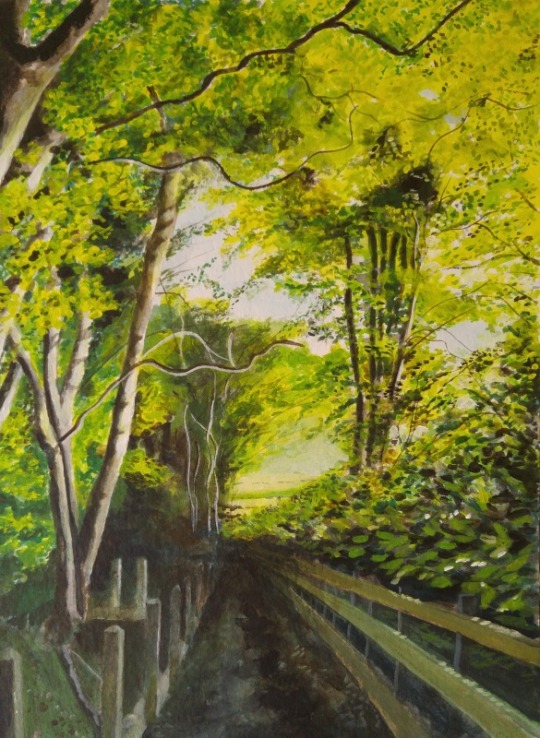
Sunlit trees tower above a shaded lane in Wrecclesham, Surrey. The lane is known as Brown’s Walk, but who Brown was, and why s/he walked here I do not know. The trees offer a radiant contrast to the dark lane, the dull fence and the dismal laurel hedge.
http://bit.ly/2PGGy9G
0 notes
Photo
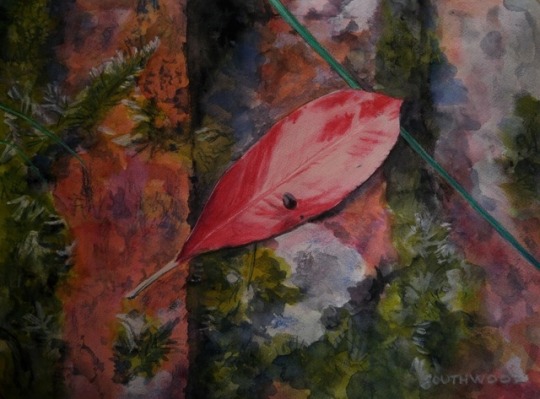
A fallen Photinia leaf lies on mossy brickwork, intersected by a blade of grass.
The shrub Photinia is in the rose family, closely related to the apple. This leaf is probably from Photinia x fraseri ‘Red Robin’, commonly used in hedging.
I’m not sure that I care for the plastic look of the whole plant, but I liked this striking juxtaposition of old brick, furry moss, shiny red leaf and the ‘cut’ of the blade of grass. The patterns of nature are rarely random – even a chance grouping such as this has context. While I didn’t set out to make a visual comment on the awful sterility of some abstract work, I see the finished painting has done just that.
http://bit.ly/2zNHkwT
0 notes
Photo
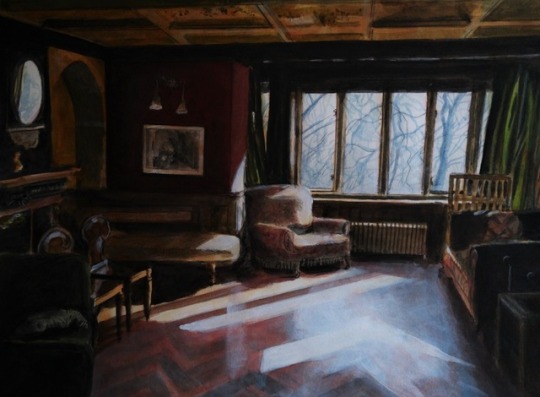
The focus of this painting of the drawing room at Limnerslease is the window and the ghostly trees beyond, framed like a painting is framed, and perhaps contemplated similarly.
I don’t often want to paint interiors, but I was struck with the light pouring into the drawing room of Limnerslease, the home of the high Victorian symbolist painter and sculptor G. F. Watts. It was the home too of his wife Mary Fraser Tytler (who I think of as a more interesting artist than her famous husband).
http://bit.ly/2v5ESBj
0 notes
Photo
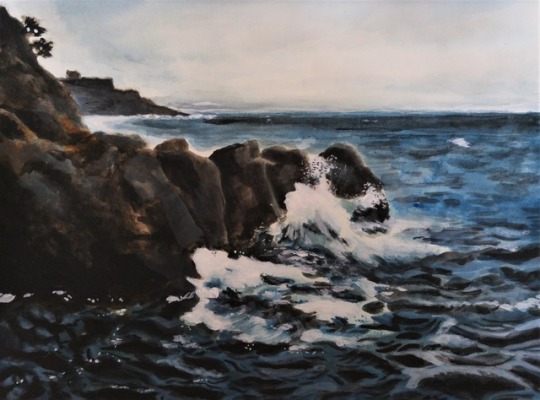
I’ve forgotten where I made the sketch for this study of waves on Guernsey rocks – my reference photo had no location either, but I’m guessing that the rocks are somewhere a little north of Jerbourg Point and the distant cliffs are Clarence Battery.
The light in Guernsey is almost always strong, even when the sky is overcast. The sun is invisible but is still reflected on the waves crashing onto the rocks. I can hardly think of a more enjoyable thing than to sit and watch great waves at work. The sounds, the smell – they are with me constantly.
http://bit.ly/2Hu669S
0 notes
Photo
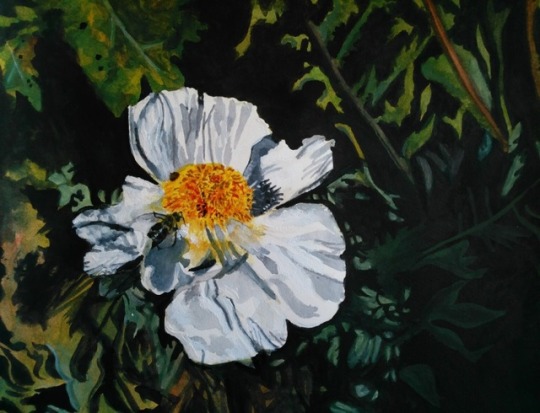
I grew up familiar with this Californian/Mexican import, the largest of the poppies. The one in the garden at home might not have been 2.5 metres tall, but it had the same giant white crumpled flowers with their glorious golden sunburst. I photographed this particular California Tree Poppy at the Chelsea Physic Garden. It was very popular with the garden’s honey bees – I put two of them in the painting (though one is hard to spot). The breeze and the persistence of the bees spread the golden pollen onto the petals like butter on slices of bread.
I greatly admire botanical paintings but they are not for me – I don’t have the patience. For this piece, I painted a lot of negative spaces for the leaves and rendered the background dark and stygian to contrast with the flower – the star of the show. I left the brushstrokes as abstract and expressionist as possible, and I am satisfied that the result works as both a representation of a California Tree Poppy and as a painting as well.
http://bit.ly/2of5qc2
0 notes
Photo
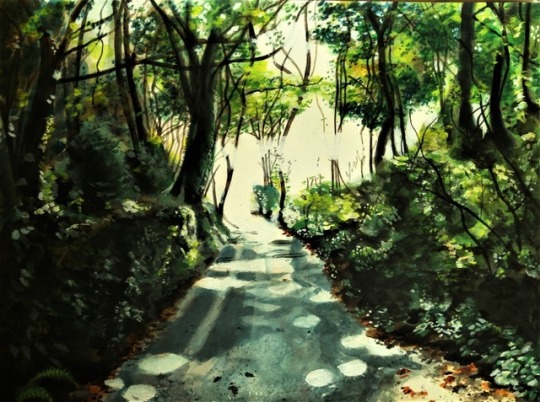
This a country lane somewhere in Guernsey. The point of the painting is, of course, the light – which is also the vanishing point. Walking in a place like this, with the sun on one’s face, is transformative. Nature is the only reality (not politics or economics), and humans are a part of that reality. Without human agency this view would not exist: humans have moulded the land, making the lane and very probably planting the trees. It is when human agency overreaches, becoming dominant and toxic, that problems appear.
http://bit.ly/2HHKx33
0 notes
Photo
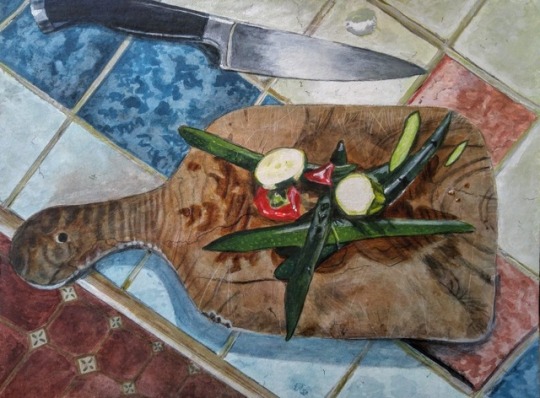
One evening I was taken by the geometry of kitchen tiles, and the lines of the knife and vegetable parings on a chopping board. The scene had some interesting technical areas: the suffuse colours of the tiles, wood grain, shadows and bright reflections. It was a good candidate for a recent Open Studio event. Next time I’ll work on something much bigger so that people can see what is going on!
http://bit.ly/2NgeqNl
0 notes
Photo
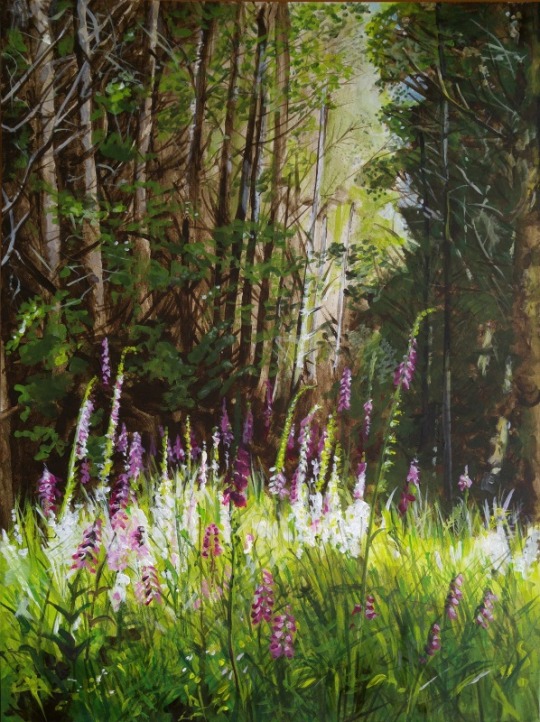
The name Alice Holt does not refer to a person called Alice. It is generally accepted that ‘Alice’ is a corruption of Ælfsige, the Bishop of Winchester who had rights over this particular Holt, or Forest. It is often seen rendered as ‘Alice Holt Forest’ – which would mean ‘Ælfsige’s Forest Forest’! Aldershot, by comparison, means Alder Forest, the ‘holt’ corrupted to ‘shot’.
The wood is managed by the Forestry Commission, a body first created to manage supplies of wood following the Great War, then to encourage repopulation of upland areas. Alice Holt is largely planted with pine (though parts still have oak trees) and this monoculture has had a predictable effect on wildlife. Nonetheless, pockets exist, and this is one of them – an army of foxgloves in a bright sunlit glade between stands of trees that block out the light.
Apparently, there has been much debate on the etymology of ‘foxglove’. This OUP article debunks the rather lovely idea of ‘Folks (Fairies) gloves’, but it is a suspiciously flattening piece.
As usual, this painting is about light, the contrast between the dark wood and the bright clearing. But it is also about form – the verticals of the mostly broad-leaved trees to the left and the sombre dominance of the pines to the right, and the matching upright foxgloves (I wonder whether John Wyndham was thinking of foxgloves when he wrote Day of the Triffids).
http://bit.ly/2TUBFwG
0 notes
Photo
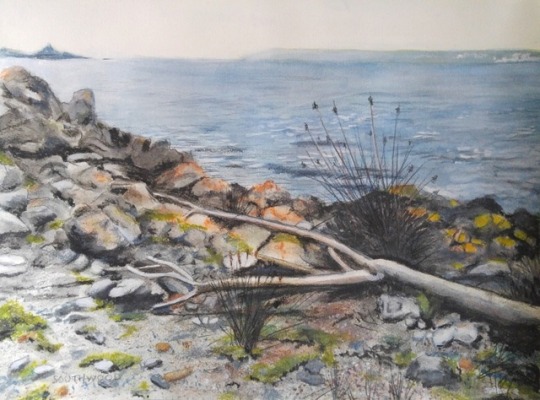
Another in my series of Channel Island paintings, this sketch – mostly in water-soluble coloured pencil – is a view towards the coast of Guernsey from a tiny ‘beach’ on the island of Herm.
This is a favourite place of mine. The exquisite beach hosts a few clumps of Common Rush, presumably sustained by a small underground stream, that must survive being regularly swamped with seawater during storms. Colourful lichens grow on the rocks and a rich flora inhabits the stones and pebbles. This is a vulnerable spot; the smallest rise in sea level would obliterate it.
The islet on the left of the horizon is Crevichon and just behind and to the left, there is a glimpse of the larger island Jethou, once connected to Herm.
The driftwood has been rendered smooth by the operation of sea and sand and bleached by the sun. I was struck by how this natural sculpture resembled the skeleton of a whale, and I reflected on the commonality of things, the underlying similarity of form.
http://bit.ly/2kyWXmb
0 notes
Photo
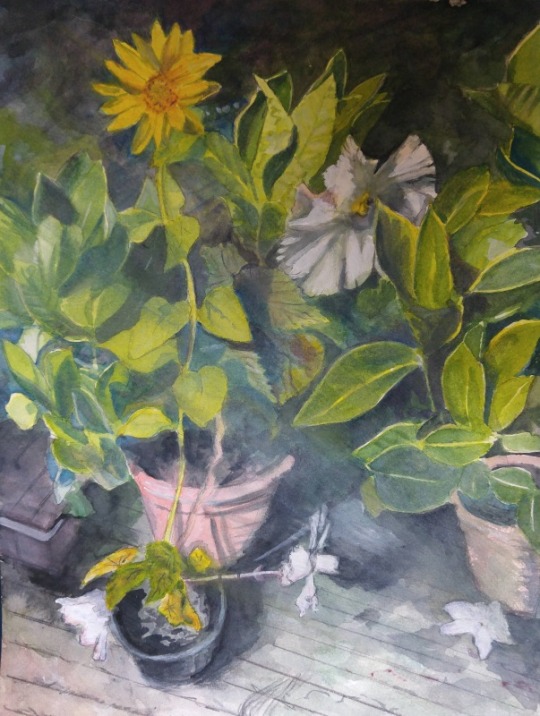
I was working on the potting table when I stepped back and saw that adding a pot with a rather weedy sunflower and a white begonia had inadvertently created rather a nice arrangement. The composition seemed to lend itself to watercolours.
http://bit.ly/2OKtQ9L
0 notes
Photo
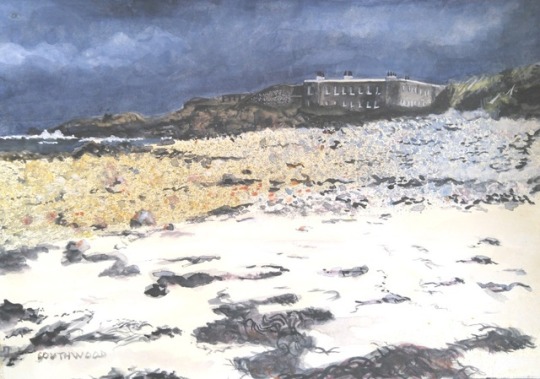
Continuing my series of Channel Island paintings, here’s a view of the Victorian fort Château à L’Etoc in Alderney. The view is from Saye Bay (pronounced Soy), one of Alderney’s many beautiful beaches.
The island’s history is a troubled one. During the German WWII occupation of the Channel Islands, Hitler deemed Alderney to be of vital strategic importance. From 1942 to 1944 the land just south of Saye bay was the site of Lager Norderney, one of four camps built by the Nazis to house workers needed to build a vast network of tunnels and fortifications. Lager Norderney was a concentration camp that housed Russian slave workers, at first under the control of the Organisation Todt and subsequently the SS. Nowadays, the area is a campsite for holidaymakers.
Hitler’s paranoid delusion regarding the importance of the Channel Islands was as much a folly as the earlier Victorian paranoia regarding Napoleon III. The island was ringed with batteries – Château à L’Etoc itself was built in 1855 to mount 23 guns and a complement of 128 men. France and Great Britain became allies just a year later.
The name of the fort, Château à L’Etoc, means fort of the sea stack (it is built on a promontory). Note the similarity to Les Etacs, the stacks, that you can see in another of my paintings.
Thunderheads look menacing as they loom darkly above the fort. But island weather is not like weather on the mainland, and this storm might be over in minutes, or it might break at sea. Bright sunshine floods the beach, offering a stunning contrast.
http://bit.ly/2uwRDmX
0 notes
Photo
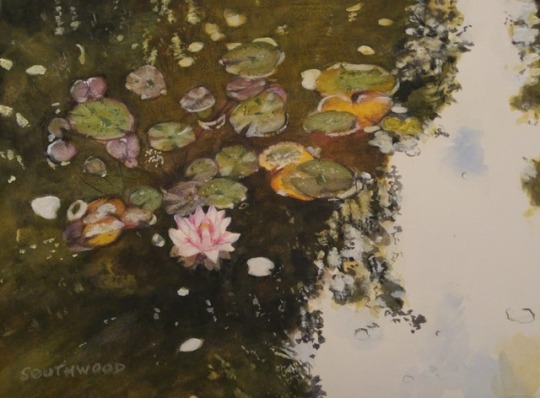
Another in what is turning into a series of Water lily paintings.
The mood here is sombre, the palette has a Victorian quality of decaying varnish. Just one water lily flower emerges, improbably, from the dark pond. A bright reflected sky, mostly cloudy, provides a stark contrast to the darkness – though even the muddy gloom possesses its own light.
http://bit.ly/2AqcgRk
0 notes
Photo

In a water meadow near Winchester, you can find these British White cattle grazing peacefully. I liked the chaotic shape of the dead tree - now in use as a scratching post for the cattle.
http://bit.ly/2HqUl0q
0 notes
Photo
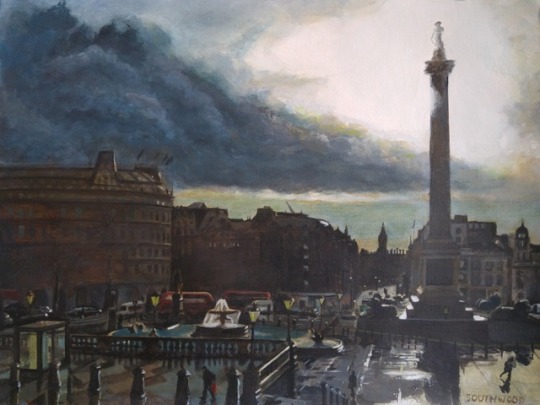
It seems that I’ll do anything to avoid difficult work – even by giving myself other difficult work. This particular distraction, Trafalgar Square in London directly after a fierce thunderstorm, is a scene I’ve wanted to paint for some time. The clouds and sun totally overwhelm the grand architecture of the South African High Commission and Nelson’s column.
I call the painting ‘London Pride’, but I don’t mean it in a good way. The buildings are dark lumps, unimportant relics compared with the drama of the passing thunderstorm.
http://bit.ly/2fB0gaw
0 notes
Photo
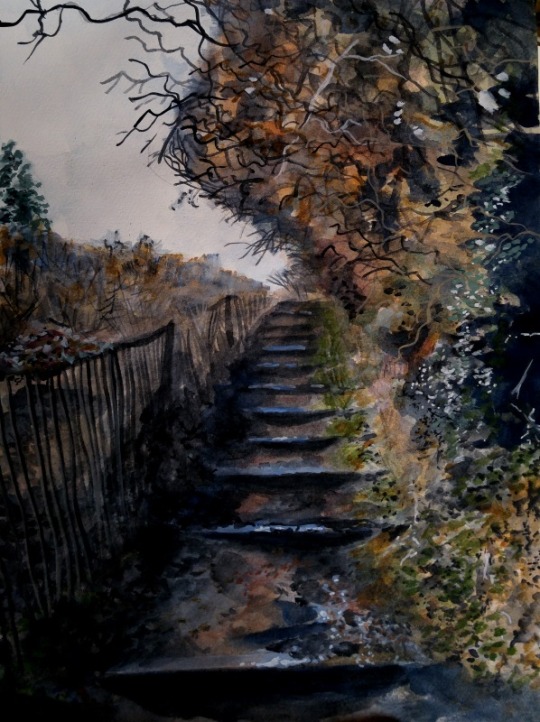
Here some steep and muddy steps rise from a culvert to the hard pale light of a winter afternoon. The stiff questing fingers of twigs and branches push through the ivy and holly, and a decrepit fence collapses with the energy of the blackthorn and hawthorn hedge. I think that staying present to the seasons is an important thing to do, so as much as I dream of gaudy flowers and blue seas, this is still a time for the introspection of Winter.
http://bit.ly/2mSlL7p
0 notes
Photo
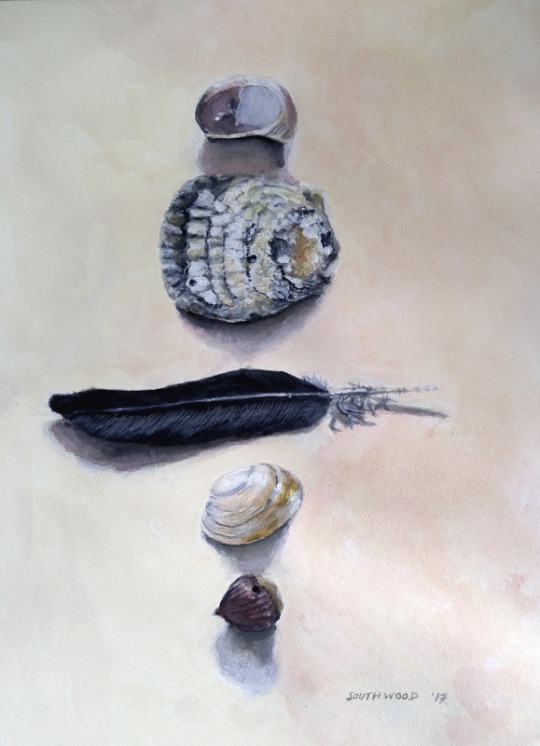
Colour plates in books are wonderful things, particularly old ones. The yellowing paper, the ranks of insects, lichens and plants that look as if they have been painted from dead specimens on pins (and probably were), and the arcane taxonomies, all contribute to the rather strange testament to life in death that is the colour plate.
I have any number of annoying small boxes containing found objects. Their provenance grows fainter with time, and I have no idea where I was when I collected these items. I had been looking for something unrelated when I came across these items and realised that I could paint something that combined both objets trouvés and the colour plate. As always, the subject comes from outside, not from some location inside me. It is the external world that shapes us.
As ‘colour plate’ the painting shows the following (top to bottom):
Slipper limpet (Crepidula fornicata – a wonderful name!)
Native Oyster (Ostrea edulis)
Unknown feather, probably a Blackbird (Turdus merula)
Hmm – work in progress, maybe the Surf clam (Spisula solida)
A hazelnut (Corylus avellana)
I used watercolour and gouache (the latter for chalky texture and body). It was pleasing to combine these things for shape and texture, and then further explore those qualities in the paint. Seen from a distance, there is also a sense of a tribal sigil, but this is a happy accident.
http://bit.ly/2rMawBK
0 notes